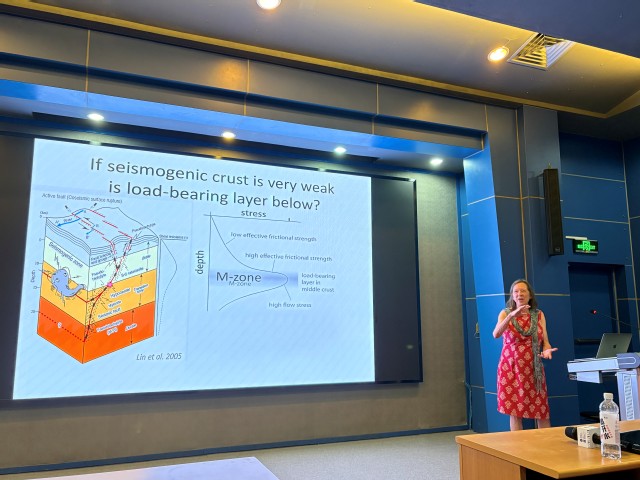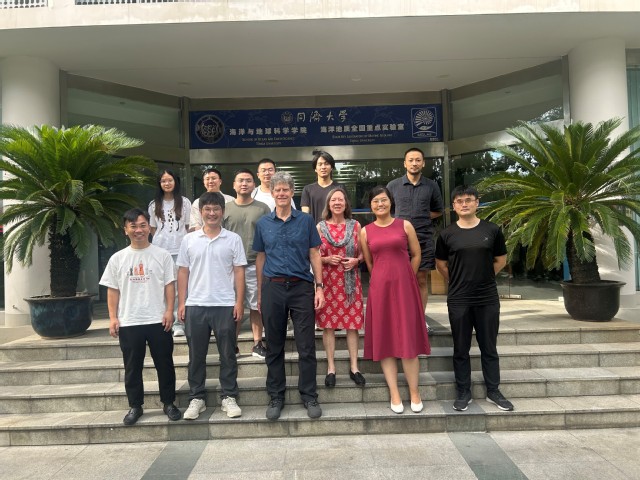At the invitation of Professor Cheng Yifang, Professor John Vidale and Heidi Houston from the University of Southern California (USC) visited our institute on July 7th, 2025, and delivered two academic talks as part of the 59th Blue Ocean Forum. Themed “How Faults Break: Crustal Strength and the Geometry of Earthquake Rupture,” the forum focused on cutting-edge scientific questions such as seismic energy release, fault zone complexity, and the strength of the Earth’s crust.
Professor John Vidale is a professor of Seismology and Dean’s Chair at USC. He earned his Ph.D. from Caltech in 1986 and has previously held positions at the UC Santa Cruz, the U.S. Geological Survey (USGS), UCLA, and the University of Washington, where he served as Director of the Pacific Northwest Seismic Network (PNSN). As a leading expert in earthquake physics, Earth structure and ground shaking hazards, Professor Vidale has published over 200 research papers, including 20 in Nature or Science. His work has been cited over 17,000 times (h-index: 69). His honors include the AGU’s Macelwane Medal (1994), UW’s College of the Environment Researcher of the Year (2011), USC Dornsife Communication Award (2023) and election to the U.S. National Academy of Sciences in 2017.

In his presentation entitled “Earthquake energy-moment ratio scales with rupture complexity,” Professor Vidale shared findings from a global study of 15 strike-slip earthquakes. The research reveals that earthquakes occurring along more geometrically complex fault systems tend to release greater amounts of high-frequency seismic energy, which in turn can result in more intense ground shaking. He emphasized that earthquake ruptures rarely propagate along a single planar fault; instead, many faults consist of intricate networks of multiple, intersecting fractures. Professor Vidale suggested that assessing fault complexity through microseismic activity may significantly enhance our ability to estimate the potential damage of future large earthquakes.
Professor Heidi Houston is a professor in the Department of Earth Sciences at USC. She previously held academic appointments at the University of Washington and several campuses of the University of California. Her research centers on earthquake source processes, slow slip events, deep earthquakes, and seismic tremor mechanisms, with a goal of understanding fault mechanics at plate boundaries and in the deep crust. She has published over 100 papers in leading journals including Nature, Science, and Nature Geoscience, and has organized several AGU Chapman Conferences and served as an editor for special issues of Geochemistry, Geophysics, Geosystems (G-Cubed).

In her talk titled “Mapping of absolute stresses around Ridgecrest California earthquake reveals a very weak crust,” Professor Houston presented the latest results from her team’s analysis of the 2019 Ridgecrest earthquake sequence in California. Using high-resolution inversions of thousands of aftershocks, they were able to directly quantify the absolute stress levels in the local crust. The findings were striking: the crust in this region appears to be exceptionally weak, with stress magnitudes amounting to only a small fraction of what classical models had predicted. This suggests that during a major earthquake, most of the accumulated stress may be released at once, thereby reducing the likelihood of subsequent immediate large aftershocks. This findings offer new insights into earthquake rupture processes and the mechanisms of post-seismic stress recovery.

The two talks led to lively discussions on topics such as “Are more complex faults more dangerous?” and “Can absolute stress distributions help forecast aftershock patterns?”. The 59th Blue Ocean Forum not only showcased cutting-edge advances in fault rupture mechanics and seismic energy radiation but also provided valuable academic inspiration for ongoing research in source physics and crustal rheology within our institute.
Looking ahead, the State Key laboratory of Marine Geology will continue to strengthen international academic collaboration with top research teams around the world, aligning with national strategic needs and advancing our understanding of the physical mechanisms of earthquake initiation and rupture, contributing to earthquake hazard mitigation and the broader field of geodynamics.


